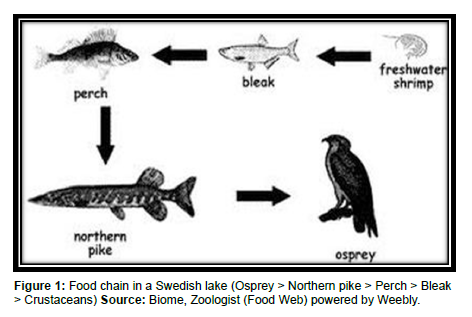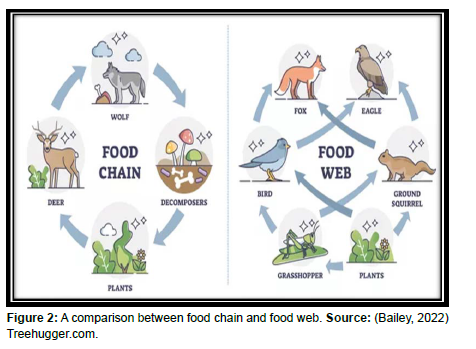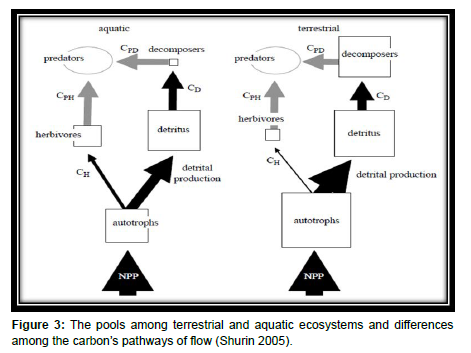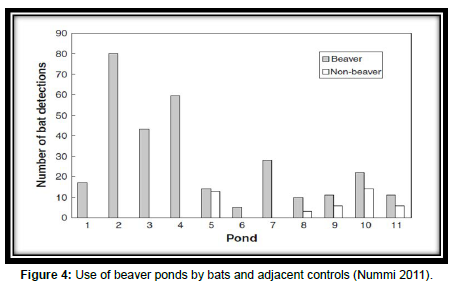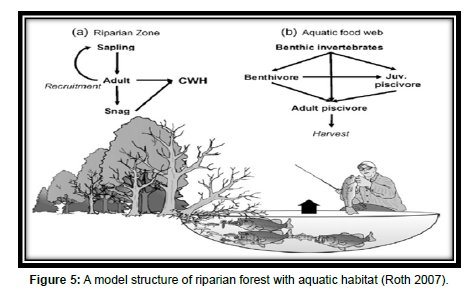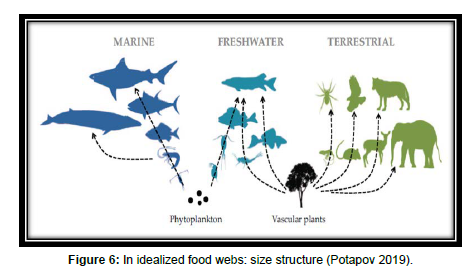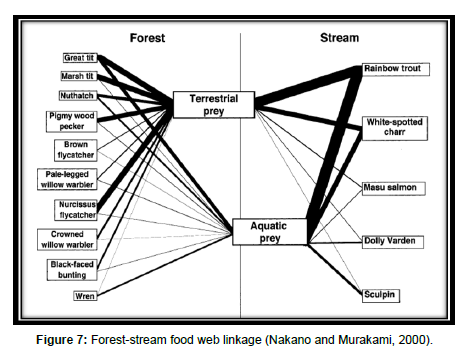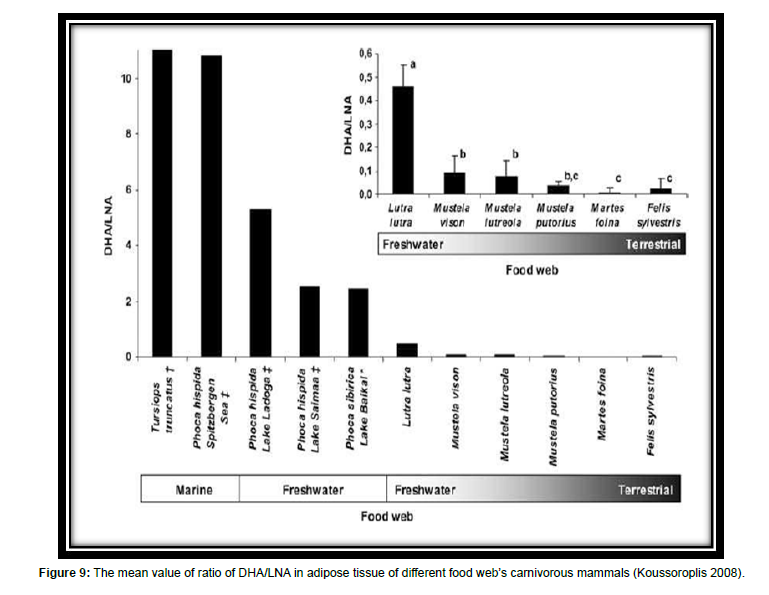Terrestrial and Aquatic Food Webs: Interlinking the Food Webs
Received: 17-Aug-2022 / Manuscript No. jee-22-72183 / Editor assigned: 18-Aug-2022 / PreQC No. jee-22-72183(PQ) / Reviewed: 31-Aug-2022 / QC No. jee- 22-72183 / Revised: 05-Sep-2022 / Manuscript No. jee-22-72183(R) / Accepted Date: 12-Sep-2022 / Published Date: 12-Sep-2022 DOI: 10.4172/2157-7625.1000350
Abstract
The food chains make interconnections to form a large or complex food web. The terrestrial and aquatic food webs are different from each other in some perspectives e.g. biogeochemistry, life history, growth rates, resource pulses persistency and physical properties of water and air. But both food webs of aquatic and terrestrial ecosystem also share the some similarities e.g. need of scavengers to both. The terrestrial food webs and aquatic food webs are interlinked and provide the reciprocal subsidies to each other. The main purpose to study the food webs in different ecosystems (Aquatic and terrestrial) is to know about the different patterns of nutrients and energy flow through one food web to another. And also to explore and know about the dependency of food webs of different ecosystems on each other. Riparian forests, river banks and streams etc. are the ideal places to observe the interlinking of terrestrial and aquatic food webs, there can be measurement of prey flux occur easily and consumption by consumers also. It still remains somehow controversial and poorly elucidated to know and understand the causes of systematic variations between the ecosystems. Much of speculations have derived from the contrasts of terrestrial ecosystems and aquatic ecosystems. The terrestrial food webs and aquatic food webs are highly interlinked; the disturbances in one ecosystem cause the disturbance in both. The human activities have bad impacts on the both ecosystems. The need of study of food webs is very necessary because the species are interlinked and the removal or extinction of even one species due to the human activities can cause the fall of whole food chain.
Keywords: Food chain; Food web; Trophic levels; Terrestrial Food Webs; Aquatic Food Webs; Energy Flow and Transfer
Introduction
Food chains were firstly introduced in the 10th century by an Arab scientist Al-Jahiz, and then it was more popularized by publication in a book which was published by Charles Elton in 1927 [1]. Food chain contains of a linear network of links in food web with arrangement of organisms in an order i.e. from producers to the apex predator species. The producers use radiation from the sun to make their food and the food prepared by thy process of photosynthesis. Then the energy flows to the end point of the food chain. The producers have the maximum energy. The energy reduces gradually as it moves towards the predators from producers. The food chain has a continuous variable length. It means that it provides the index of ecological structure which includes the trophic levels from lowest to high [2].
The food web is a little bit more complex then food chain i.e. the interconnections of different food chains makes a food web. The food web is a limited representation of the natural environment as it encompasses a wide range of species living into the trophic species and these are the functional group as they represent the whole species because they have the same predators and prey and some conditions in a food web. The food webs contain the two major types of organisms which are the autotrophs and heterotrophs. The autotrophs are those organisms which produce the more biomass energy while the heterotrophs consume the biomass energy rather than production of it [3]. The aquatic food webs are supported by sources of primary production which are combination of both autochthonous and the allochthonous. The primary producers of aquatic food webs lack the structural tissue and the small in size give them a benefit that they show high nutritious value for heterotrophs and also show growth with faster growth rates.
The main objective of this study to determine that how energy transfers in different patterns in terrestrial and aquatic ecosystems. Also to determine the transfer of energy between the organisms within an ecosystem. And also check how different organisms affect the structure of both food webs.
Literature Review
The understanding of those processes that regulates the dynamics in the ecosystems and trophic structure in the ecosystems has been greatly advanced by the ecologists. It still remains controversial and poorly elucidated to understand the causes of systematic variations between the ecosystems. Much of speculations have inspired by the contrast between aquatic and terrestrial ecosystems. There are evidences of systematic differences among the biomass partitioning and energy flow from lower to high trophic levels i.e. between the producers to the herbivores and from herbivores to detritus and to decomposers and lead to the higher trophic levels. The different pathways of trophic levels have difference in magnitude i.e. some have less herbivores and some have more detritus accumulations on the land and the more decomposers (Figure 1). The major difference between terrestrial food webs and the aquatic food webs occurs at primary level of productivity, this does mean that there structural differences between these two systems are present. The plants patterns of allocation in both aquatic and terrestrial environments shape the food webs to the upward. The phytoplankton i.e. which are the primary producers of aquatic food webs have no structural tissues and smaller in size, that’s why achieve the faster rates of growth and more nutritious. The contrasts among the terrestrial food webs and the aquatic food webs are based on the nutritional quality, size of the autotrophs and growth rates [4].
We take an example of bats and beavers for the interlinking of terrestrial and aquatic food webs. The populations of bats are continuously reducing in most of areas because of loss of their aquatic or wetland habitats. The beavers are the natural agents who create the wetlands. The flowages of beavers produce the higher numbers of aquatic invertebrates. The Canadian beavers Castor canadensis was introduced in the ponds where they were not present before to introducing them. By introducing the beavers in ponds there were two species of bats detected Eptesicus nilssoni and Myotis daubentoni, and these species used the beaver flowages more as compared to the nonbeaver ponds i.e. those ponds which were controlled. The bats forage in large groups above those ponds which were with the beavers (Figure 2). The habitats of bats were improved by the beaver’s flowages. The reason may be that the ponds with beavers emerge the higher numbers of insects. The management of habitats can be favored by the beavers, as they create many suitable conditions for many other species e.g. bats. The areas which are not suited for the beavers, with the man made impoundments insects production can be achieved. This phenomenon is very important for those areas where the wetlands were reduced to a few numbers [5].
The fall of trees from the riparian forests into the water bodies e.g. pond, canal, and river especially in the lakes makes the habitats for aquatic organisms. That’s why they are the link between the terrestrial and aquatic food webs. These habitats promote the invertebrate prey and are a refuge for many prey fishes (Figure 3). Residential developments and windstorms have negative impacts on the fishes and change the Coarse Woody Habitat (CWH). It is noticed that the coarse woody habitat are very important shelters for the prey fishes as compared to the benthic substrates for the invertebrate production. The harvest of piscivorous organisms can lessen the role of coarse woody habitat as a shelter. If the lake shore residential development effects the fishes then the cutting of riparian forests and trees would reduced and the coarse woody habitat for the prey invertebrates and the fishes will be declined and then the effects of the residential developments on prey fishes can be reduced by harvesting of piscivores [6].
In the marine consumers the correlation among the trophic level and body size is strong, while there is weak correlation among the trophic levels and body size in the consumers of freshwater and almost absent in the terrestrial consumers. When we compare the vertebrates with the invertebrates then it concluded to this point that the vertebrates would occupy the higher trophic positions as compared to the invertebrates. The green trophic chains are longer in aquatic as compared to the brown trophic chains (Figure 4) [7].
The mutual interactions between the trophic levels and contagious habitats have a great significance for the community maintenance in the ecological landscapes but still poorly understood. The aquatic insect emergence in the stream ecotones and the deciduous forests peaked around in spring season. While on the same time the terrestrial invertebrate’s biomass was low. The terrestrial invertebrate biomass input to the stream occurs during the summer when the aquatic biomass reduced to its lowest. This type of reciprocal prey flux across the terrestrial and aquatic food webs subsidies both terrestrial birds and the aquatic fishes (Figure 5) [8].
The dynamics in a diversity of ecosystems and productivity in a diversity of ecosystems affected by the resource pulses, these ecosystems include islands, forests, streams and lakes. The food web structures of both aquatic and terrestrial ecosystems are different and their biogeochemistry is also different. They have different responses to the resource pulses. The bottoms up effects are faster in the aquatic food webs as compared to the terrestrial food webs because of differences in the stoichiometry, growth rates, and life history (Figure 6). The resource pulses have impact of longer persistency in the terrestrial ecosystem than in aquatic food webs because the terrestrial food webs have the long lived nature of the terrestrial resource pulses and longer generation times as compared to aquatic. And also terrestrial ecosystem has the reduced top-down effects of consumers as compared to aquatic ecosystem [9].
Rivers provide the nutritional subsidies to the terrestrial food webs. It is also have empirical evidences that the primary producers of the large streams, water bodies and rivers provide large nutritional resources to the terrestrial food webs. The aquatic derived nutrition provides the energy and nutrients to both shoreline and border ranging terrestrial consumers [10]. In the current scenario there has been a lot of global changes occurred. The climatic change and the downgrading of trophics and the intrusion of invasive species, these all have aroused the surge of interest to explore more to know the differences of nutrient cycling between the ecosystems types. The importance of scavenging has emerged now especially to know the differences of scavenging dynamics between the aquatic and terrestrial ecosystems. And it is also important to know the need of research in a clear filed which focuses on the role of carrion consumption for the maintenance of the ecosystems.
The scavenging although performs the same functions in both aquatic and terrestrial ecosystems but some differences occur due to the physical properties of the air and water. The most of the organisms get nutrients and actively or passively feed on the decomposed material. The macro fauna especially in the aquatic ecosystem rely on the decomposed material especially. The removals of apex organisms from the food webs disturb the whole food webs [11]. In a study of adipose tissues, fatty acid composition observed in six species of carnivorous mammals. These species were European wild cat, Marten, European polecat, European mink, American mink and European otter. These species have different foraging behaviors i.e. they forage in both terrestrial food webs and aquatic food webs. The analyses of fatty acid composition unveiled the important dissimilarities in polysaturated fatty acids constitution in these species. It is also observed that the reduction in the Docosa Hexaenoic Acid (DHA)/Linoleic Acid (LNA) ratio in carnivorous species correlated with the decrease in the dependency of their foraging on aquatic food webs, different species have different value of DHA and LNA (Figures 7-9) [12].
Conclusion
Food chains are the linear networks of organisms with orderly arrangement. In the food chain the organisms arranged in such a manner that the producers come on first or bottom position with most of energy amount holding while the top predators come on the peak positions in a pyramid of energy. While the food webs are the complex i.e. the food webs are the interconnections of the food chains, a lot of food chains interconnect to make a complex food web. In the food webs the trophic species represent the whole members of their species. The major dissimilarities among the terrestrial food webs and aquatic food webs occur at the primary productivity level because of the structural differences between the two systems. There are differences occur in the biogeochemistry, nutritional quality, their growth rates and the size of autotrophs. Due to the difference in growth rates, the bottoms up effects are faster in aquatic food webs. Terrestrial ecosystem have reduced top-down effects of consumers due to which resource pluses’s impacts persist longer in terrestrial ecosystem. The correlation among the trophic level and body size is very strong in the consumers of marine environment, while the consumers of freshwater have weak correlation and almost absent in the terrestrial consumers. The vertebrates occupy the higher trophic positions as compared to the invertebrates. Some species of aquatic food webs get refuge from the riparian trees, prey of piscivorous species of aquatic food webs. Terrestrial food webs and aquatic food webs also subsidize each other. The reciprocal flux of prey subsidizes the organisms of both food webs. The rivers, canals, ponds and streams etc are the sources or subsidize the terrestrial food webs with energy and nutrients. The scavengers are very important in both terrestrial and aquatic food webs, as they provide the most of nutrients to the macro fauna of aquatic food webs and help to decompose and help in nutrient cycling in terrestrial ecosystem. The foraging behavior of terrestrial species effect the amount of Docosa Hexaenoic Acid (DHA) / Linoleic acid (LNA) ratio in carnivorous species. It does mean that decrease in dependency of foraging on aquatic food webs will result reduction in the Docosa Hexaenoic Acid (DHA) / Linoleic Acid (LNA) ratio in carnivorous species.
Acknowledgement
The Department of Zoology, University of Sialkot is highly acknowledged. We would like to say thanks to faculty of zoology, as they helped us to clear many doubts and concepts about research and research writing. Especially Dr. Brian Gagosh Nayyar from Department of Botany, University of Sialkot helped us a lot to let us know about research conductance, research writing and procedure of publication.
Conflict of Interest
The authors declare no conflict of interest.
References
- Egerton F N (2007) Understanding food chains and food webs, 1700-1970. Bulletin of the Ecological Society of America 88: 50-69.
- Zanden V, M J, Shuter B J, Lester N, Rasmussen J B (1999) Patterns of food chain length in lakes, A stable isotope study. The American Naturalist 154: 406-416.
- Odum EP, Barrett GW (2005) Brooks/Cole, a part of Cengage Learning, Fundamentals of Ecology (5th Edn.)
- Shurin JB, Gruner DS, Hillebrand H (2005) All wet or dried up? Real differences between aquatic and terrestrial food webs. Proc R Soc B 273: 1-9.
- Nummi P, Kattainen S, Ulander P, Hahtola A (2011) Bats benefit from beavers: A facilitative link between aquatic and terrestrial food webs. Biodivers Conserv 20: 851-859.
- Roth BM, Kaplan IC, Sass GG, Johnson PT, Marburg AE (2007) Linking terrestrial and aquatic ecosystems: The role of woody habitat in lake food webs. Ecological Modelling 203: 439-452.
- Potapov AM, Brose U, Scheu S, Tiunov AV (2019) Trophic Position of Consumers and Size Structure of Food Webs across Aquatic and Terrestrial Ecosystems. The American Naturalist 194: 6.
- Nakano S, Murakami M (2000) Reciprocal subsidies: Dynamic interdependence between terrestrial and aquatic food webs. Center for Ecological Research 52-2113.
- Nowlin WH, Vanni MJ, Yang H (2008) Comparing resource pulses in aquatic and terrestrial ecosystems. Ecology by the Ecological Society of America 89: 647-659.
- Kautza A, Sullivan SMP (2016) The energetic contributions of aquatic primary producers to terrestrial food webs in a mid- size river system. Ecology by the Ecological Society of America 97: 694-705.
- Beasley JC, Olson ZH, De Vault TL (2012) Carrion cycling in food webs: comparisons among terrestrial and marine ecosystems. Nordic Society Oikos 121: 1021-1026.
- Koussoroplis AM, Lemarchand C, Bec A, Desvilettes C, Amblard C (2008) From Aquatic to Terrestrial Food Webs: Decrease of the Docosa Hexaenoic Acid/Linoleic Acid Ratio. Lipids 43: 461-466.
Indexed at, Google Scholar, Crossref
Indexed at, Google Scholar, Crossref
Indexed at, Google Scholar, Crossref
Indexed at, Google Scholar, Crossref
Indexed at, Google Scholar, Crossref
Indexed at, Google Scholar, Crossref
Citation: Ali A, Nayyar BG (2022) Terrestrial and Aquatic Food Webs: Interlinking the Food Webs. J Ecosys Ecograph 12: 350. DOI: 10.4172/2157-7625.1000350
Copyright: © 2022 Ali A, et al. This is an open-access article distributed under the terms of the Creative Commons Attribution License, which permits unrestricted use, distribution, and reproduction in any medium, provided the original author and source are credited.
Share This Article
Recommended Journals
Open Access Journals
Article Tools
Article Usage
- Total views: 7734
- [From(publication date): 0-2022 - Apr 21, 2025]
- Breakdown by view type
- HTML page views: 7187
- PDF downloads: 547

